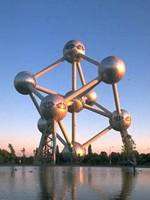
Dominating the surrounding park, the Atomium has become a symbol of Brussels
© AA Photo Library
57 BC Romans in northern Europe conquer Iron Age Belgae tribe territory, part of land now occupied by present-day Belgium.
AD 751 Carolingian Dynasty is formed; during reign of Charlemagne, Holy Roman Emperor, the Low Countries prosper.
1419 Central government established at Bruges; the city becomes a center of the cloth trade and a focus of early Flemish painters.
1519 Charles V of Spain is crowned Holy Roman Emperor; the Netherlands comes under Spanish control.
1581 The Netherlands divides into United Provinces of the Netherlands and Spanish Netherlands (Belgium).
1713 War of Spanish Succession ends; Austria controls Belgium.
1815 Congress of Vienna; Belgium and the United Provinces of the Netherlands form the Kingdom of the Netherlands, ruled from the Hague by the Dutch William of Orange.
1839 Belgian independence recognized by the (Dutch) Netherlands.
1914-18 Most of Belgium is occupied by Germany.
1940-44 Belgium again occupied by Germany.
1957 European Economic Community (now the European Union) establishes its headquarters in Brussels.
1967 NATO sets up headquarters in Brussels.
1993 Belgium signs the Maastricht Treaty, establishing the European Union.
2000 Belgium (along with the Netherlands) hosts Euro 2000, the European Football (soccer) Championships; Brussels designated a European City of Culture.
2002 Bruges designated Cultural Capital of Europe.
| COUNTRY |
| Introduction |
| Things To Know |
| Survival Guide |
| TimeLine |
| Essential Info |
| REGION |
| CITIES |
| Brussels |
| Bruges |
| Ghent |
| MAPS |
| World |
| Europe |
| TRAVEL BOOK |
 |